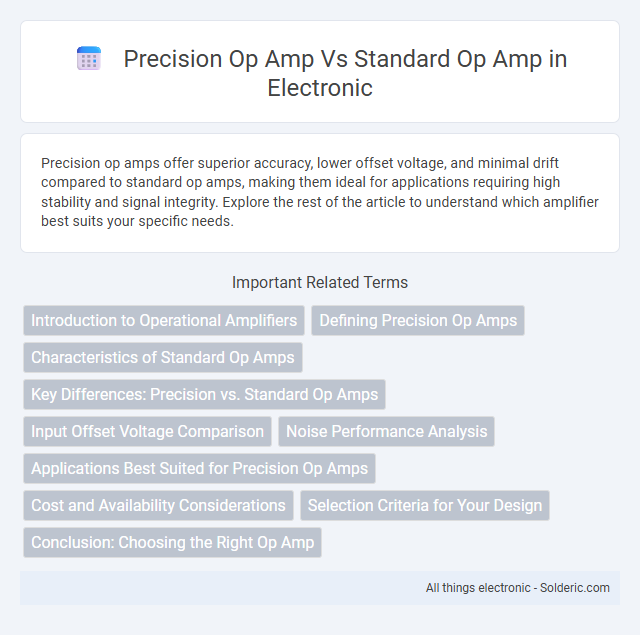Precision op amps offer superior accuracy, lower offset voltage, and minimal drift compared to standard op amps, making them ideal for applications requiring high stability and signal integrity. Explore the rest of the article to understand which amplifier best suits your specific needs.
Comparison Table
| Feature | Precision Op Amp | Standard Op Amp |
|---|---|---|
| Input Offset Voltage | Very low (microvolts to millivolts) | Higher (millivolts) |
| Input Bias Current | Extremely low (picoamperes to nanoamperes) | Higher (nanoamperes to microamperes) |
| Voltage Noise | Low (few nV/Hz) | Higher noise levels |
| Temperature Drift | Minimal (uV/degC) | Higher drift |
| Gain Accuracy | High precision, stable gain | Standard accuracy |
| Power Consumption | Moderate to low | Varies, often higher |
| Cost | Higher | Lower |
| Typical Applications | Precision measurement, sensor interfaces, instrumentation | General purpose amplification |
Introduction to Operational Amplifiers
Operational amplifiers (op amps) are fundamental components in analog electronics, designed to amplify voltage signals with high gain. Precision op amps offer enhanced accuracy, low offset voltage, and minimal drift, making them ideal for applications requiring exact signal amplification and stable performance. Standard op amps provide general-purpose amplification with sufficient gain but lack the specialized features that ensure precision and stability in sensitive electronic circuits.
Defining Precision Op Amps
Precision op amps feature low offset voltage, minimal drift, and high input impedance, making them ideal for accurate signal processing in measurement and sensor applications. Unlike standard op amps, precision types are designed to maintain stable performance under varying temperatures and supply voltages, ensuring reliable and precise amplification. Your choice of op amp significantly impacts the accuracy and stability of sensitive analog circuits.
Characteristics of Standard Op Amps
Standard op amps typically feature moderate input offset voltage, limited bandwidth, and higher noise levels compared to precision op amps, making them suitable for general-purpose applications. They exhibit input bias currents in the nanoampere range and gain bandwidth products around 1 MHz to 10 MHz. These characteristics define their use in less critical analog signal processing where extreme accuracy and low drift are not essential.
Key Differences: Precision vs. Standard Op Amps
Precision op amps provide superior accuracy with low offset voltage, low drift, and high open-loop gain, making them ideal for sensitive measurement applications. Standard op amps typically have higher offset and noise levels, suitable for general-purpose amplification where extreme precision is not critical. Understanding these key differences helps you choose the right op amp to optimize your circuit's performance.
Input Offset Voltage Comparison
Precision op amps typically feature input offset voltages in the microvolt range, often below 10 uV, significantly lower than standard op amps that commonly exhibit offset voltages in the millivolt range, around 1-5 mV. The reduced input offset voltage in precision op amps enhances measurement accuracy by minimizing output errors caused by input bias. This characteristic is crucial for applications requiring high accuracy and low drift, such as sensor signal conditioning and instrumentation.
Noise Performance Analysis
Precision op amps offer significantly lower noise density compared to standard op amps, making them ideal for applications requiring high signal integrity. Your choice of a precision op amp reduces input-referred voltage noise and current noise, enhancing overall system accuracy in low-level signal processing. This superior noise performance is critical in medical instrumentation, sensor interfaces, and measurement equipment where maintaining signal fidelity is essential.
Applications Best Suited for Precision Op Amps
Precision op amps excel in applications requiring high accuracy, low offset voltage, and minimal drift, such as sensor signal conditioning, medical instrumentation, and high-resolution data acquisition systems. Their low noise and stable parameters make them ideal for precision voltage references, instrumentation amplifiers, and analog-to-digital conversion circuits. You will benefit from precision op amps when designing equipment that demands consistent and reliable measurements over various environmental conditions.
Cost and Availability Considerations
Precision op amps typically incur higher costs due to enhanced manufacturing processes and tighter performance specifications, such as lower offset voltages and improved temperature stability. Availability of precision op amps may be more limited compared to standard op amps, as they often require specialized sourcing from select manufacturers. Standard op amps are widely available and more cost-effective, making them suitable for general-purpose applications with less stringent accuracy requirements.
Selection Criteria for Your Design
Precision op amps excel in low offset voltage, low bias current, and high input impedance, making them ideal for sensor signal conditioning and instrumentation applications where accuracy is critical. Standard op amps suit general-purpose uses emphasizing cost and speed over exactitude, often preferred in audio amplification or basic filtering tasks. Choosing between them depends on your design's tolerance for error, bandwidth requirements, and power consumption constraints.
Conclusion: Choosing the Right Op Amp
Precision op amps offer superior accuracy, low offset voltage, and minimal drift, making them ideal for applications requiring high fidelity and stability such as instrumentation and sensor signal conditioning. Standard op amps are cost-effective and sufficient for general-purpose tasks where ultra-high precision is not critical. You should choose a precision op amp when measurement accuracy and low noise are paramount, while standard op amps serve well in less demanding applications to optimize cost and performance.
precision op amp vs standard op amp Infographic

 solderic.com
solderic.com